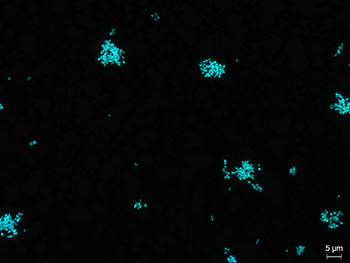Minerva Biolabs는 세포배양 및 바이오의약품에서의 mycoplasma, bacteria, virus를 검출/오염방지/제거 등 컨트롤할 수 있는
고품질의 다양한 키트와 제품을 제공하는 독일 소재의 제조사입니다.
Jun 21, 2024 | Informative Articles

Mycoplasma contamination remains a persistent challenge in cell culture laboratories and the biopharmaceutical industry. Detection of mycoplasma contamination is crucial for maintaining the reliability and reproducibility of cell-based experiments and is essential to ensure the safety and quality of biopharmaceutical products. Since mycoplasma are invisible to the naked eye and do not cause turbidity in the growth medium it is difficult to detect a contamination.
This article provides an overview of various methods available for mycoplasma detection, highlighting their principles, advantages, and limitations.
Mycoplasma can be detected by a culture-based method. This compendial method is the gold standard and is described in the European, United States and Japanese Pharmacopeia. Two test methods are used - the culture method and the indicator cell culture method.

The test sample is inoculated directly into a broth medium. The liquid cultures are subcultured at multiple time points onto agar plates to visualize mycoplasma growth. At the end of the incubation period, the presence of mycoplasma colonies is examined by microscope. The total test takes at least 28 days to produce a negative test result.
Not all mycoplasma strains can be successfully cultured by the conventional culture method because they do not grow in the standard media. The indicator cell culture test is performed by transferring the sample into a Vero cell culture. After 3-5 days incubation the indicator cells are stained with Hoechst DNA stain and examined under the microscope for surface fluorescence. This method is faster than the culture-based method but is less sensitive and still takes several days to complete. [1], [2]
 Stained mycoplasma cells
Stained mycoplasma cellsA simple way to test for the presence of Mycoplasma in your cell culture is DNA staining e.g. with DAPI (4',6-diamidino-2-phenylindole) or Hoechst. DAPI intercalates strongly into the minor groove of DNA and shows a blue staining that can be visualized by UV excitation (460 nm) using a fluorescence microscope. In mycoplasma-free cell cultures, only cell nuclei are labelled. If mycoplasma cells are present their DNA will be labelled too.
Although DNA staining is an easy and rapid test, sometimes interpreting the results can be difficult and some experience is definitely necessary. Due to their small size, single mycoplasma cells cannot be detected under fluorescence microscope. This means that only a high degree of contamination leads to a visible obscure veil formation, which may not be clearly identifiable. Furthermore, if the condition of cell culture is not good, the DNA staining results can be misinterpreted. [1]
 Exemplary agarose gel image
Exemplary agarose gel imageIn some cases, a faster method is required, especially if the product to be released has a short shelf life (e.g. ATMPs). The majority of rapid mycoplasma detection methods are PCR-based methods, which are accepted by regulatory authorities as an alternative to conventional culture-based methods.
 Exemplary qPCR amplification plot
Exemplary qPCR amplification plotMycoplasma are specifically detected by amplifying a highly conserved 16S rRNA coding region in the mycoplasma genome. PCR-based methods are highly sensitive compared to culture-based or staining methods. It is possible to detect mycoplasmas in cell cultures in a very early state of contamination and low concentrations. Compared to the culture or staining method, PCR analysis delivers accurate and highly sensitive results in a few hours. Mycoplasma can be detected via conventional PCR and subsequent gel electrophoresis, via real-time PCR or digital PCR. These easy, rapid, efficient and cost-effective methods deliver highly sensitive, specific and reliable results.
 Minerva Biolabs launched the world’s first mycoplasma PCR assay validated according to Ph. Eur. 2.6.7 in 2006.
Minerva Biolabs launched the world’s first mycoplasma PCR assay validated according to Ph. Eur. 2.6.7 in 2006.Other technologies have also been used to rapidly detect mycoplasma contaminations, such as ELISA, fluorescence in situ hybridization (FISH) or bioluminescence assays. These methods have largely been superseded by PCR-based methods. Therefore, we have only compared the culture method, DNA staining and PCR method below:
difficult, especially if cell culture isin poor conditionExperience is necessaryNo discrimination between live and dead cellsRapid (few hours)Broad detection rangeLittle hands-on timeHighly sensitive and specificNo living mycoplasmas requiredfor positive control & validationTakes 28 daysLabour-intensiveRequires living mycoplasma cellsfor positive control & validationCulture methodDNA stainingPCR | qPCR | dPCRAdvantagesDisadvantages

[1] Nikfarjam L, Farzaneh P. Prevention and detection of Mycoplasma contamination in cell culture. Cell J. 2012 Winter;13(4):203-12. Epub 2011 Dec 22. PMID: 23508237; PMCID: PMC3584481.[2] Drexler HG, Uphoff CC. Mycoplasma contamination of cell cultures: Incidence, sources, effects, detection, elimination, prevention. Cytotechnology. 2002 Jul;39(2):75-90. doi: 10.1023/A:1022913015916. PMID: 19003295; PMCID: PMC3463982.